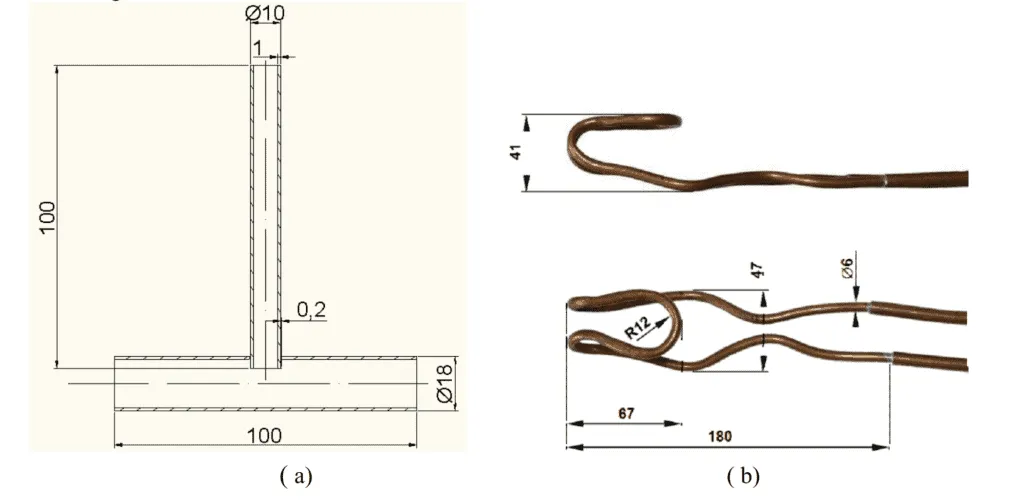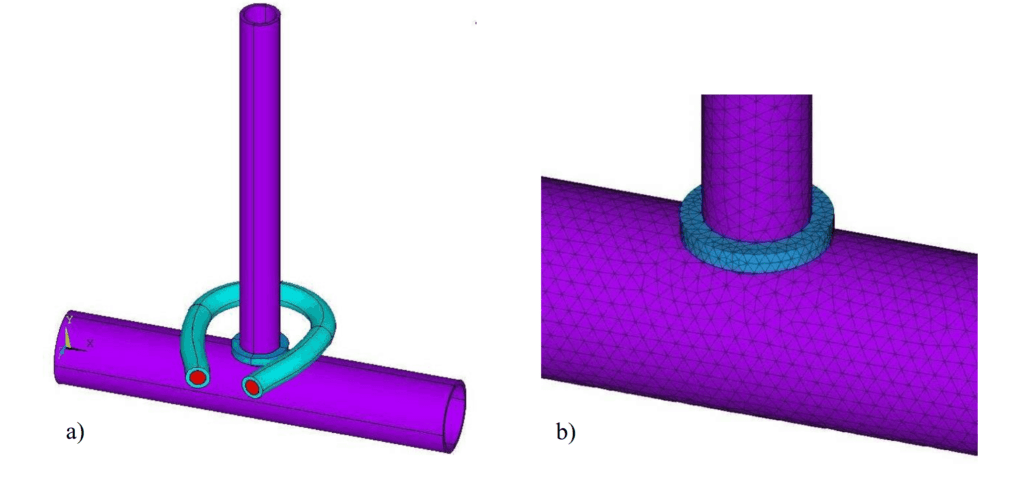Induction Brazing Aluminum Tubes with High Frequency Induction Heating
The novel applications areas of induction heating require analyzing the temperature distribution inside the heated components taking into account the corresponding structures and the material properties. The finite element method (FEM) provides a powerful tool to perform such analyses and optimization of induction heating processes through coupled electromagnetic and thermal numerical analyses and simulations.
The main aim of this contribution is to indicate the possibility of application of the proper, sophisticated and efficient induction brazing technology for the manufacturing of solar collectors based on numerical simulation and performed experiments.
Problem description
This work deals with the design of components for solar collectors suitable for brazing process, namely the parts of collecting tubing (Fig. 1a). Tubes are made from the Al alloy of the AW 3000 type with the chemical composition given in the Table 1. For brazing, the alloy of Al 104 type is used (Table 2) together with the flux Braze Tec 32/80 which residues are non-corrosive. The temperature interval between solidus and liquidus temperatures for the Al 104 brazing alloy ranges from 575 °C to 585 °C. The solidus temperature of the tube material is 650 °C.
Table 1 Chemical composition of AW 3000 alloy [wt. %]
| Si | Fe | Cu | Mn | Mg | Zn | Cr | Al |
| 0.05-0.15 | 0.06-0.35 | max. 0.1 | 0.3-0.6 | 0.02-0.20 | 0.05-0.3 | max. 0.25 | balance |
Table 2 Chemical composition of the brazing alloy of the Al 104 type [wt. %]
| Si | Fe | Cu | Mn | Mg | Zn | Ti | Al |
| 11-13 | 0.6 | max. 0.3 | 0.15 | 0.1 | 0.2 | max. 0.15 | balance |
The brazing process supposes the application of induction heating. It is necessary to design the system of induction heating in such a manner that brazing temperatures should be achieved in the joint zone (brazed metals – brazing alloy) in the same time. From this viewpoint, a proper selection of induction coil, its geometry and operation parameters (mainly the frequency and the source current) is very important. The shape and dimensions of the designed copper water-cooled induction coil are shown in Fig. 1b
The effect of relevant parameters of induction heating on the temperature distribution in the brazed parts was assessed using the numerical simulation of induction heating applying the program code ANSYS 10.0.
Simulation model
In accordance with the methodology of solution of coupled electromagnetic and thermal problems by FEM using the ANSYS 10.0 software [3-5], the simulation model of induction heating process for brazing was developed including geometrical, physical, and initial and boundary conditions. The main aim of numerical simulation was to define the optimum parameters of induction heating (the frequency and the source current) to achieve the required temperature distribution in the zone of joint formation.
Suggested 3D-model (Fig. 2) for electromagnetic analysis consists of the model of tubes, brazing alloy, water-cooled induction coil and surrounding air (not shown in Fig. 2). In the thermal analysis, only the tubes and brazing alloy were considered. A detail of the mesh generated from the linear, 8-node elements in the zone of joint formation is illustrated in Fig. 2b.
Fig. 2 a) Geometrical model for electromagnetic analysis without surrounding air and b) detail of the 3D mesh generated in the zone of joint formation.The temperature dependences of electric and thermal properties of AW 3000 alloy and Al 104 brazing alloy were obtained using JMatPro software [6]. Following from the fact that the applied materials are non-magnetic, their relative permeability µr = 1.
The initial temperature of brazed materials was 20 °C. Perfect electric and thermal contacts on the boundary surfaces of materials were supposed. The frequency of the source current in the induction coil was supposed to be 350 kHz. The value of the source current was defined from the interval from 600 A to 700 A. Cooling of the brazed tubes by free convection and radiation to the air with the temperature of 20 °C was taken into account. Combined heat transfer coefficient dependent on the surface temperature of brazed parts was defined. In Fig. 3, the temperature distribution in brazed components after the achievement of required temperatures in the joint zone are shown for chosen values of applied source currents in induction heating coil. The time of 36 seconds using the source current of 600 A seems to be quite long. The fast heating applying the source current of 700 A cannot be sufficient for the melting of the Al 104 brazing alloy. In this reason the source current approximately of the level of 620 A to 640 A is recommended leading to the brazing times from 25 to 27.5 seconds……




